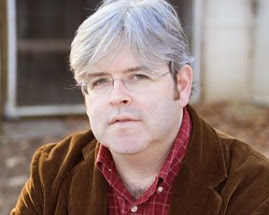 The tumult of the autumn at Richard Byrne Inc. led me to put a number of essential tasks to side. One of the most important was to obtain the long-awaited Prisonshake double record -- Dirty Moons -- and let it sink in long enough to have something intelligent to say about it.
The tumult of the autumn at Richard Byrne Inc. led me to put a number of essential tasks to side. One of the most important was to obtain the long-awaited Prisonshake double record -- Dirty Moons -- and let it sink in long enough to have something intelligent to say about it.Finally did so. Put simply, Dirty Moons is more than worth the 15 year wait since the last Prisonshake record, 1993's The Roaring Third.
You're excused if you're not familiar with the 'Shake. God knows they can be hard enough to track down. Infrequent gigging. A back catalogue scattered over mere continents. But when the band has erupted into song (1986-1992ish in Cleveland; 1993-1995 in St. Louis; now), they're among the best rock bands in the United States: brainy without being wonky, muscular riffs bouncing off lyrics both cynical and tender.
Ringleader Robert Griffin (who also runs Scat Records) and lead vocalist Douglas Enkler have formed the spine of the band from its conception, but the addition of drummer Patrick Hawley and bassist Steve Scariano added power and fluidity to the band that really pays off on Dirty Moons.
In line with the "brainy not wonky" line above, while there is no high concept here, there are some elegant conceits and jagged formalistic moves (the "suite" on side two; traditional vinyl sides dubbed as "multiple entry points"). Don't let them turn you on or put you off. Most of what's here is good ol' American rock and roll -- recorded in analog at various levels of fidelity but with unflagging inventiveness and energy.
I could reel off a bunch of moments that stand out on multiple listens: "Fake Your Own Death" swerves from its jammy introduction into moody and sinister Jeff Beckisms before disintegrating and coalescing again a few times, or the moment when that aforementioned side two suite revs up for take off on "Rebecca, You're the Rain."
But for me what shines through are the sometimes dueling, but more often complementary sensibilities of Griffin and Enkler. For all of his dinged and dented hardboiled aesthetic shell, Griffin writes some of the best love songs in rock. (Just check out the furious romanticism of "Dream Along," or the unabashed erotic revelry of "Crush Me" -- the latter song married to smash and grab riffing.)
And Enkler? Well, the acidity of his observations cut through any and all bullshit posing, and the record is studded with his sharp lyrical gems. "The Cut-Out Bin" is worth quoting at length because of the song's savage look-back-in-anger at a life in rock:
Back in the day, before songs were numbered
And only bikers and sailors had tattoos
I'd work all day, selling records to assholes
Huffing boo and screwing you
Some say rock and roll has died
And at times like these I wish they were right
Watch 'em spawn a litter, watch none survive
No one gets a twilight to their career anymore
No one gets a chance to make
Mediocre record number four
When they bring back the cut-out bin
Save a place for us behind the Pretty Things
The other highlight on the record for me is Enkler's performance on "Fuck Your Self-Esteem," which may be one of the most finely-chiseled bits of rock on the topic of sexual mayhem ever penned, and yoked to savage riffs that propel the song along:
Well the next free moment she tells me, "fuck you"
I say that's not nice I'm the only one who loves you
That's not a brain, that's flaps and triggers
Slots and levers like a Mousetrap game
Does someone need a punch in the mouth?
Please don't let on that I knew you when....
You can get Dirty Moons on e-music, but everybody (except me, of course) makes more money if you order it directly from Scat Records. (The Dirty Moons page at the Scat site also has an mp3 of "Crush Me.") Griffin also keeps an indifferently updated blog about the record; there's plenty of cool back matter there.






